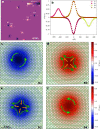Properties and dynamics of meron topological spin textures in the two-dimensional magnet CrCl3
- PMID: 33420050
- PMCID: PMC7794561
- DOI: 10.1038/s41467-020-20497-2
Properties and dynamics of meron topological spin textures in the two-dimensional magnet CrCl3
Abstract
Merons are nontrivial topological spin textures highly relevant for many phenomena in solid state physics. Despite their importance, direct observation of such vortex quasiparticles is scarce and has been limited to a few complex materials. Here, we show the emergence of merons and antimerons in recently discovered two-dimensional (2D) CrCl3 at zero magnetic field. We show their entire evolution from pair creation, their diffusion over metastable domain walls, and collision leading to large magnetic monodomains. Both quasiparticles are stabilized spontaneously during cooling at regions where in-plane magnetic frustration takes place. Their dynamics is determined by the interplay between the strong in-plane dipolar interactions and the weak out-of-plane magnetic anisotropy stabilising a vortex core within a radius of 8-10 nm. Our results push the boundary to what is currently known about non-trivial spin structures in 2D magnets and open exciting opportunities to control magnetic domains via topological quasiparticles.
Conflict of interest statement
The authors declare no competing interests.
Figures





References
-
- Guguchia, Z. et al. Magnetism in semiconducting molybdenum dichalcogenides. Sci. Adv.4. https://advances.sciencemag.org/content/4/12/eaat3672 (2018). - PMC - PubMed
LinkOut - more resources
Full Text Sources
Other Literature Sources

